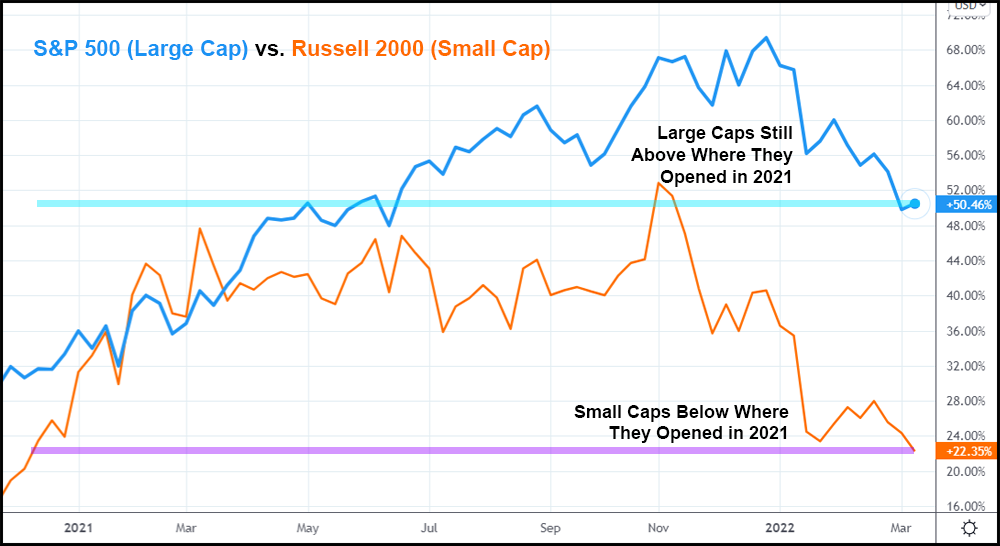Stocks jumped higher this morning as oil prices continued to slide. The February Producer Price Index (PPI) was released, too, revealing a slightly “cooler” than expected print. Last month, the PPI rose 0.8% month-over-month (MoM), bringing the producer inflation reading to +10.0% year-over-year (YoY). Analysts expected the PPI to rise 0.9% MoM by comparison.
Core PPI, which excludes food and energy costs, rose 0.2% MoM vs. 0.6% expected. And though the headline PPI number hit double-digits YoY (+10.0%), the weak core PPI print appeared to have encouraged some bullish enthusiasm among traders.
Today’s burst higher, however, may also have been a simple “bounceback rally” in response to the market’s recent downturn.
“Because this market has been so weak, so unconvincing since its all-time high on January 3, and because of intraday reversals, no one really knows what will end up being,” said CFRA chief investment strategist Sam Stovall.
“But what is causing the market to be totally in the green today is it’s just getting tired of going straight down for such an extended period. So even if this were simply a relief rally, I think we are due for one.”
Last week’s massive intraday reversals had typically stoic analysts looking somewhat more animated than usual. Morning commentaries were invalidated quickly as the war in Ukraine caused sentiment to flip several times, often within the spawn of only a few hours.
Tomorrow, Fed Chairman Jerome Powell is set to reveal a rate hike following the conclusion of the March FOMC meeting. And, depending on the size of the hike, the market could endure yet another intraday sentiment shift for the record books.
“The market is jittery,” remarked Gene Goldman, chief investment officer at Cetera Investment Management.
“So much concern about the Russian invasion, inflation, and the Fed. With growing concerns of a bear market, investors have been skittish.”
The S&P is currently down roughly 12% from its all-time high. If it falls 20%, it would qualify as being in a bear market – something investors haven’t seen since Covid hit.
But the bear market is already here for small-cap stocks. And in the process of forming that bear market, small-caps have completely erased their 2021 gains.

The reason for this is that S&P stocks continued to post strong earnings last year. Forward guidance deteriorated over the last earning’s season, which helped spark the 2022 selloff. But in 2021, the going was mostly good.
Contrast that with the small-cap Russel 2000, which tracks the market’s 2000 smallest stocks. Many analysts – myself included – use the Russell 2000 to gauge the US economy’s overall health, as 90% of the stocks included in the index derive their revenues from the US. The S&P only takes in about 40-50% of its revenues domestically by comparison.
Small-cap earnings went from bad to worse last year, and because of that, the index sunk. It’s now below where it opened in 2021 vs. the S&P, which is still trading well above where it was at the start of last year.
Historically, Russell 2000 bear markets have preceded recessions. It may not seem like a recession is imminent to investors who only watch the S&P. But the reality is that a recession is almost guaranteed given how poorly small caps have done. This year, consumer sentiment plunged as well while oil prices exploded higher. In fact, every time crude oil has risen by at least 50%, a recession has followed in the US.
Oil soared over 80% higher from trough-to-peak over the last several months.
As a result, the Fed is being forced to tighten into what looks like an impending recession. That puts Powell in an extremely tough spot.
We’ll find out what he decides to do tomorrow afternoon, and, depending on how he leans (hawkish or dovish), stocks should react accordingly in the short term.
Keep in mind, however, that the US economy’s longer-term problems – high inflation, reduced earnings, and high commodity prices – should persist.
Regardless of the size of Powell’s hike.







